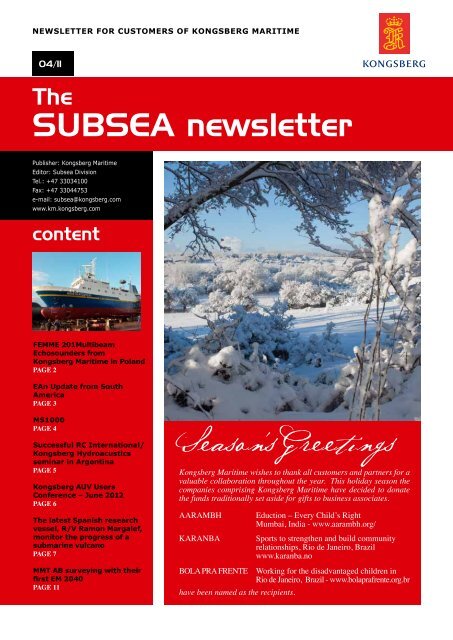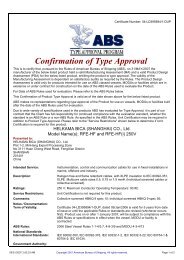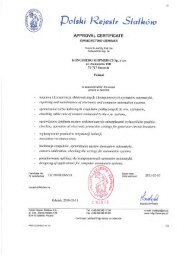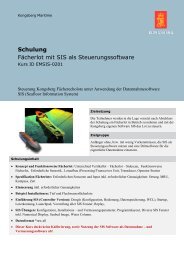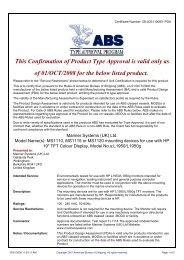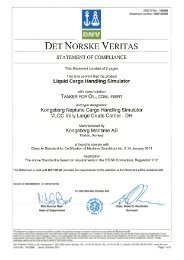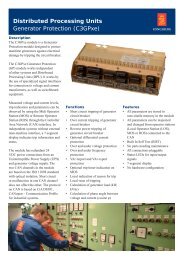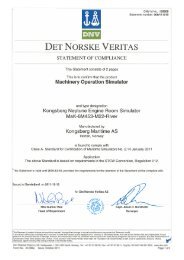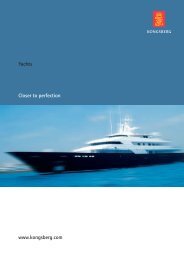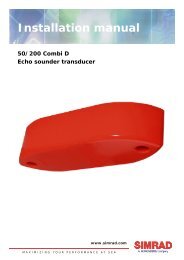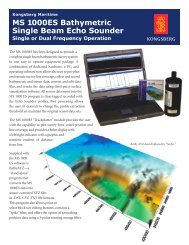No. 4 - December 2011 - Kongsberg Maritime
No. 4 - December 2011 - Kongsberg Maritime
No. 4 - December 2011 - Kongsberg Maritime
Create successful ePaper yourself
Turn your PDF publications into a flip-book with our unique Google optimized e-Paper software.
NEWSLETTER For customers of kongsberg MARITIME<br />
04/11<br />
The<br />
SUBSEA newsletter<br />
Publisher: <strong>Kongsberg</strong> <strong>Maritime</strong><br />
Editor: Subsea Division<br />
Tel.: +47 33034100<br />
Fax: +47 33044753<br />
e-mail: subsea@kongsberg.com<br />
www.km.kongsberg.com<br />
content<br />
FEMME 201Multibeam<br />
Echosounders from<br />
<strong>Kongsberg</strong> <strong>Maritime</strong> in Poland<br />
PAGE 2<br />
EAn Update from South<br />
America<br />
PAGE 3<br />
MS1000<br />
PAGE 4<br />
Successful RC International/<br />
<strong>Kongsberg</strong> Hydroacustics<br />
seminar in Argentina<br />
PAGE 5<br />
<strong>Kongsberg</strong> AUV Users<br />
Conference – June 2012<br />
PAGE 6<br />
The latest Spanish research<br />
vessel, R/V Ramon Margalef,<br />
monitor the progress of a<br />
submarine vulcano<br />
PAGE 7<br />
MMT AB surveying with their<br />
first EM 2040<br />
PAGE 11<br />
S e a s on’sG re e t in g s<br />
<strong>Kongsberg</strong> <strong>Maritime</strong> wishes to thank all customers and partners for a<br />
valuable collaboration throughout the year. This holiday season the<br />
companies comprising <strong>Kongsberg</strong> <strong>Maritime</strong> have decided to donate<br />
the funds traditionally set aside for gifts to business associates.<br />
Aarambh<br />
Karanba<br />
Eduction – Every Child’s Right<br />
mumbai, India - www.aarambh.org/<br />
Sports to strengthen and build community<br />
relationships, Rio de Janeiro, Brazil<br />
www.karanba.no<br />
Bola Pra Frente Working for the disadvantaged children in<br />
rio de Janeiro, Brazil - www.bolaprafrente.org.br<br />
have been named as the recipients.
The SUBSEA NEWSLETTER page 2<br />
DECEMBER <strong>2011</strong><br />
Successful product<br />
seminar in Spain<br />
Multibeam Echosounders from<br />
<strong>Kongsberg</strong> <strong>Maritime</strong> in Poland<br />
Part of the <strong>Kongsberg</strong> <strong>Maritime</strong> sales<br />
team who carried out the presentations.<br />
On September 13th and 15th, two<br />
seminars for <strong>Kongsberg</strong> <strong>Maritime</strong><br />
Subsea products were given in Madrid<br />
and Cádiz respectively.<br />
The first, held at the Hotel AC Carlton<br />
in Madrid, consisted of several<br />
system presentations and was wellreceived<br />
by well-known customers<br />
and other companies with important<br />
projects in progress.<br />
In Cádiz, the seminar was held in<br />
Baluarte de los Mártires, located in<br />
the old headquarter of the city just<br />
on the seaside, which was a fortress<br />
part of the fence wall around Cádiz<br />
city. The grand building featured a<br />
huge conference room able to hold<br />
a large audience and a nice terrace<br />
overlooking the sea.<br />
Attendees were able to see the wide<br />
range of systems with a common<br />
technology root based on extensive<br />
experience and reputation from<br />
<strong>Kongsberg</strong> <strong>Maritime</strong>.<br />
It was a comprehensive agenda that<br />
included the following updates:<br />
• Hydrography, Multibeam and<br />
Singlebeam echosounder, side scan<br />
sonars, sub-bottom profiler and<br />
other bathymetric sonars.<br />
• Acoustic Instrumentations with<br />
the new positioning systems.<br />
• Cameras and scanning sonars.<br />
• Autonomous Underwater<br />
Vehicles - AUV´s families.<br />
• Reference and motions systems.<br />
In addition a special presentation<br />
was held, describing <strong>Kongsberg</strong><br />
<strong>Maritime</strong>’s capabilitieson doing<br />
projects integrating the groups<br />
whole product range. Examples<br />
from latest projects was given.<br />
NAWIGATOR XXI, a training vessel<br />
owned by <strong>Maritime</strong> University in Szczecin,<br />
has been equipped with the first<br />
multibeam echosounder EM 710 in Poland,<br />
capable of operating at the depths<br />
of up to 2000m.<br />
The echosounder has been delivered<br />
and installed by Escort Ltd and the final<br />
stage of installing the transducers<br />
was conducted by Mr Terje Moe and<br />
Mr Jørgen Hamre, representatives from<br />
<strong>Kongsberg</strong> Company. Transducers Tx<br />
and Rx were mounted at the bow of the<br />
vessel during its stay at dry dock in Szczecin<br />
Ship Repair Yard ’Gryfia’. The<br />
installation of the whole system took<br />
place in September <strong>2011</strong>.<br />
In the first week of October, a five-day<br />
long sea trial was carried out on the Baltic<br />
Sea. The trials and calibration of the<br />
system culminated successfully and the<br />
system worked very well, even during<br />
rough weather conditions.<br />
The installation of the transducer at the<br />
bulbous bow as a result gave very good<br />
acoustic conditions for operation of the<br />
system. This mounting spot was proposed<br />
by Mr Bjorn Hoyum Larsen during<br />
his visit to Szczecin in August. At<br />
that time, a few various other mounting<br />
spots were considered. One of mounting<br />
option was on the gondola under<br />
the vessels hull, which, was rejected as<br />
it would change the parameters of the<br />
vessel’s submersion and increase the installation<br />
costs. The ship owner wanted<br />
to avoid such a situation. The technical<br />
documentation regarding transducers’<br />
installation was prepared by the MID-<br />
CON – the Designe Office, while the<br />
documentation of electrical installation<br />
was prepared by Escort Ltd.<br />
At present, <strong>Maritime</strong> University also<br />
owns the GeoSwath Plus 250 kHz multibeam<br />
echosounder, which is installed<br />
on HYDROGRAF XXI - another small<br />
training vessel.<br />
Moreover, the <strong>Maritime</strong> Office in Szczecin<br />
owns two EM 3002D systems and<br />
the Hydrography Office of the Polish<br />
Navy in Gdynia has two EM 3002D systems<br />
as well. The Port Authority Gdansk<br />
also has one EM3002S system and<br />
a very similar one is owned by Gdańsk<br />
University of Technology. In <strong>December</strong><br />
<strong>2011</strong>, another GeoSwath Plus 500 kHz<br />
system will be delivered to the Hydrographic<br />
Office of the Polish Navy in<br />
Gdynia.
The SUBSEA NEWSLETTER page 3<br />
DECEMBER <strong>2011</strong><br />
NOAA and Partners demonstrated success of<br />
EM 302 Multibeam Echosounder to detect and<br />
map deep-sea gas seeps<br />
knowledge of the marine environment,<br />
including the distribution of natural<br />
sources of methane input into the ocean<br />
and the identification of communities of<br />
life that are often associated with methane<br />
gas seeps,” said Thomas Weber, Ph.D., of<br />
the University of New Hampshire’s Center<br />
for Coastal and Ocean Mapping and<br />
lead scientist of the mission.<br />
Multibeam sonar, an echo sounding<br />
technology commonly used to map the<br />
seafloor, can also be used to map and detect<br />
gaseous seeps in the water column,<br />
according to scientists testing the technology<br />
on board NOAA Ship Okeanos<br />
Explorer in the Gulf of Mexico.<br />
Following an earlier test in 2009 on<br />
Okeanos Explorer’s multibeam sonar<br />
off the U.S. West Coast, the most recent<br />
expedition in the Gulf was the first comprehensive<br />
test of Okeanos Explorer’s<br />
multibeam to detect deep gaseous seeps<br />
over a wide area. Its use during this mission<br />
confirms the effectiveness of the<br />
tool and may lead to extending NOAA’s<br />
water-column mapping capabilities.<br />
The expedition was conducted jointly<br />
by NOAA’s Office of Ocean Exploration<br />
and Research (OER), the University<br />
of New Hampshire’s Center for Coastal<br />
and Ocean Mapping and the Bureau of<br />
Ocean Energy Management, Regulation<br />
and Enforcement (BOEMRE), as well as<br />
scientists and technicians from NOAA’s<br />
Southeast Fisheries Science Center working<br />
in parallel from NOAA Ship Pisces.<br />
With the Gulf of Mexico home to numerous<br />
gaseous seeps, data collected by<br />
multibeam sonar could prove valuable to<br />
researchers planning further studies of<br />
gas seeps and their effects on the marine<br />
environment.<br />
The objective of the expedition was to<br />
test the sonar’s ability to map gaseous<br />
seeps, not oil, as oil is more difficult to<br />
acoustically detect with the multibeam<br />
sonar. Techniques developed during<br />
this cruise are intended to help scientists<br />
better understand detection of gas<br />
seeps which may in turn better inform<br />
scientists who are working on techniques<br />
to map oil in the water column.<br />
“This capability will help increase our<br />
“Mapping the seafloor and the water<br />
column are essential first steps in exploring<br />
our largely unknown ocean.<br />
This expedition confirms earlier indications<br />
that multibeam technology provides<br />
a valuable new tool in the inventory<br />
to detect plumes of gas in the water<br />
column, and especially in deep water,”<br />
added Weber.<br />
Bill Shedd, a BOEMRE geophysicist<br />
and expert in hydrocarbon seeps who<br />
participated in the expedition as part of<br />
an ongoing collaboration with NOAA’s<br />
OER, stated, “Our agencies have been<br />
working together in the Gulf of Mexico<br />
since 2003. We’re optimistic and impressed<br />
about this new capability for<br />
exploration that was demonstrated so<br />
well during this expedition.”<br />
An Update from South America<br />
Chile<br />
<strong>Kongsberg</strong> Maritme AS Hydrographic Departement has been awarded a<br />
contract by the Chilean Hydrographic and Oceanographic Service (SHOA) for<br />
the supply of new survey equipment for the hydrographic survey vessel PSH<br />
Cabrales. The supply consists of one EM 3002 Dual, one EM 710 1x2 one<br />
EA 400, sensors, spareparts and services. The plan is to have the equipment<br />
delivered and installed during the first half of 2012. We previously supplied<br />
EM 3002 systems to two of SHOA’s other vessels, the PSG Micalvi and PSG<br />
Ortiz, which are both in operation.<br />
Peru<br />
<strong>Kongsberg</strong> Maritme AS Hydrographic Departement has been awarded a<br />
contract by the Hydrographic Office in Callao, Lima, Peru (Direccion de<br />
Hidrografia y Navigacion - DHN) for the supply of one EM 3002 Dual, one<br />
Seapath 330, sensors and services. The equipment will be used for shallow<br />
water mapping and mapping of rivers and waterways. The system will be<br />
installed on DHN’s new shallow water survey vessel during the last part of<br />
<strong>2011</strong> and first half of 2012.
The SUBSEA NEWSLETTER page 4<br />
DECEMBER <strong>2011</strong><br />
Unique Antique for<br />
the Hydrographic<br />
Institute Museum<br />
in Cádiz<br />
MS1000<br />
Remote TS Pte Ltd, a Singapore-based inspection and survey company,<br />
were contracted to provide overview images of a wellhead<br />
template, prior to removal and after the wellheads and template<br />
had been removed. The only solution was to use the KONGSBERG<br />
MS1000 Imaging Sonar to take a number of images and then stitch<br />
them together to form a mosaic.<br />
Donation ceremony: Jan Haug Kristensen<br />
representing <strong>Kongsberg</strong> <strong>Maritime</strong> is<br />
handing over the instrument to Chief<br />
Commander Moreu from Hydrographic<br />
Institute in Cadiz.<br />
In connection with the <strong>Kongsberg</strong> <strong>Maritime</strong><br />
Subsea product seminar in Cádiz<br />
on September 15th, Simrad Spain and<br />
<strong>Kongsberg</strong> <strong>Maritime</strong> Subsea took the<br />
opportunity to donate an antique navigation<br />
instrument to the Hydrographic<br />
Museum in Cádiz, administrated by the<br />
Hydrographic Institute.<br />
This antique navigation instrument is<br />
a Graphometer double telescope with<br />
compass from 1771 built by Meurand<br />
- Quai del Horloge - Paris. This instrument,<br />
preserved in an excellent condition,<br />
is a unique and historical article<br />
for the museum’s unique collection of<br />
items related to the history of hydrography.<br />
The Graphometer was used for<br />
topographic and cartographic applications<br />
on azimuthal and vertical angle<br />
measurements.<br />
The donation ceremony took place at<br />
the Hydrographic Museum building in<br />
Cádiz, and the Hydrographic Institute<br />
Director, Chief Commander Guillermo<br />
Moreu, accepted the donation on behalf<br />
of the museum. The ceremony was<br />
attended by key people from the Hydrographic<br />
Institute together with the<br />
<strong>Kongsberg</strong> <strong>Maritime</strong> Subsea sales team<br />
who participated in the product seminar.<br />
A guided tour in the museum was<br />
also arranged to view the unique collection<br />
of hydrographic history.<br />
The equipment was deployed on the vessel<br />
and excellent images were obtained<br />
that were post processed using GIMP<br />
software into a mosaic showing the ‘as<br />
found’ and ‘as left’ condition of the site.<br />
The operators of the equipment found it<br />
very easy to set up and acquire the images.<br />
The equipment was deployed using<br />
a tripod arrangement manufactured<br />
for this particular project. The tripod<br />
and sonar head were deployed by hand<br />
to a depth of 65 metres. This arrangement<br />
worked for this project but a more<br />
robust deployment system is being designed<br />
to enable us to work at greater<br />
depths and currents. The system was<br />
also fitted to an ROV as an alternative<br />
deployment method. However, the ROV<br />
was used for other tasks and so the hand<br />
deployment method was used in this<br />
case.<br />
The client was extremely happy with the<br />
results and we look forward to carrying<br />
out similar work with them in the future.<br />
The company is actively looking for<br />
other projects using the MS1000 both<br />
offshore in the Oil and Gas industry and<br />
for onshore civil inspection projects.<br />
Roddy Macdonald, Managing Director,<br />
Remote TS Pte Ltd, said: “We are very<br />
grateful to Grant Rawlinson at <strong>Kongsberg</strong><br />
<strong>Maritime</strong> Pte Ltd, Singapore, for<br />
all the assistance received to successfully<br />
complete this project. For us, this was<br />
a new way of carrying out inspection<br />
and we were very encouraged by the<br />
results and are looking to expand our<br />
capability with the MS1000 as I think<br />
it has great potential in many different<br />
markets.”
The SUBSEA NEWSLETTER page 5<br />
DECEMBER <strong>2011</strong><br />
Successful RC International/<strong>Kongsberg</strong><br />
Hydroacustics seminar in Argentina<br />
On October 11th <strong>2011</strong>, RC International<br />
(<strong>Kongsberg</strong> <strong>Maritime</strong>’s representative<br />
in Argentina) and <strong>Kongsberg</strong> <strong>Maritime</strong><br />
Subsea Division successfully arranged a<br />
Hydroacoustics seminar in Buenos Aires,<br />
Argentina.<br />
The goal was to update all customers<br />
about the latest <strong>Kongsberg</strong> <strong>Maritime</strong><br />
Presenters on hand to guide delegates<br />
through the technology and results were;<br />
Finn Otto Sanne, Product Manager Motion<br />
Sensors at <strong>Kongsberg</strong> Seatex; Ralf<br />
Timm, Vice President Sales at Geosented<br />
all <strong>Kongsberg</strong> <strong>Maritime</strong> subsea<br />
products. Alan Rozenblum and Hernan<br />
Patrich, from RC International hosted the<br />
seminar and presented Seatex products.<br />
“The goal was to gather the key players<br />
from the industry in one room and show<br />
<strong>Kongsberg</strong>’s commitment towards our<br />
market. It’s a growing market in Argentina<br />
with a many challenges, so we need<br />
to position ourselves in the customer’s<br />
head so that when the budget increases,<br />
they will come to us,” said Alan Rozenblum,<br />
Director of RC International.<br />
Ing. Hernán Patrich Cohen of RC International,<br />
commented on the high attendance:<br />
“There aren’t many seminars<br />
on hydroacoustics in Argentina, and we<br />
usually have to travel many miles to<br />
be part of them, so when we have the<br />
chance to attend this kind of presentations<br />
in our own country, we don’t miss<br />
the opportunity.”<br />
<strong>Kongsberg</strong> <strong>Maritime</strong> Ltd Hosts Successful<br />
Subsea Seminar in Aberdeen<br />
Aberdeen-based <strong>Kongsberg</strong> <strong>Maritime</strong><br />
Ltd host the <strong>Kongsberg</strong> <strong>Maritime</strong><br />
Subsea Seminar <strong>2011</strong>, which featured<br />
presenters from across the <strong>Kongsberg</strong><br />
Subsea product groups and attracted<br />
almost 80 people from across the UK<br />
survey market.<br />
The theme of this year’s event was ‘Integrating<br />
a New Generation of Technology’<br />
and presentations focussed both on new<br />
developments in <strong>Kongsberg</strong> equipment<br />
and the integration of this technology with<br />
other products to achieve the best results.<br />
The presentations were mostly application<br />
technology and its applications.<br />
The seminar gathered around 100 participants<br />
from all sectors: Hydrographic<br />
Services, Oil Companies, Navy, private<br />
survey companies, Coast Guard, Research<br />
Institutes, marine contractors<br />
and technical support agents.<br />
KM Subsea sales team Americas preorientated,<br />
with data and conclusions from<br />
recent successful projects interspersed<br />
throughout the talks.<br />
The event was a big success and an ideal<br />
setting to showcase the latest technologies<br />
to existing and potential customers.<br />
With a large number of key customers<br />
opting to attend, it also proved a great<br />
networking opportunity. The aim of the<br />
seminar was to not only present new<br />
products and technology to customers,<br />
but to also present new ways of utilising<br />
<strong>Kongsberg</strong> technology. By enhancing<br />
the technical and practical knowledge<br />
amongst companies and individuals,<br />
this will ensure that users are maximising<br />
productivity of the equipment they<br />
have invested in.<br />
acoustics; Berit Horvei, Product Manager<br />
Multibeam; Craig Wallace, Senior<br />
Subsea Engineer; Ian Florence, Subsea<br />
Acoustic Specialist; Jan Erik Faugstadmo,<br />
Vice President UNAV, and Einar<br />
Gustafson, Sales Manager AUV.<br />
In addition, there was also various operational<br />
equipment and models on<br />
hand which provided a visual and practical<br />
element to proceedings. Working<br />
equipment included a HiPAP 351, cPAP,<br />
c<strong>No</strong>de Maxi and c<strong>No</strong>de Mini. Multibeam<br />
software SIS was also set up on<br />
replay mode showing data captured during<br />
a recent project. Models on show included<br />
a HiPAP 500, EM 2040, full-size<br />
REMUS 100 AUV model and a scaled<br />
version of the HUGIN 3000 AUV.<br />
The <strong>Kongsberg</strong> <strong>Maritime</strong> Subsea Seminar<br />
also saw the unveiling of the new<br />
<strong>Kongsberg</strong> <strong>Maritime</strong> T-shirt design,<br />
created exclusively for <strong>Kongsberg</strong> by<br />
Ian Florence.
The SUBSEA NEWSLETTER page 6<br />
DECEMBER <strong>2011</strong><br />
<strong>Kongsberg</strong> AUV Users Conference – June 2012<br />
The <strong>Kongsberg</strong> Group is pleased<br />
to announce the second REMUS/<br />
HUGIN AUV Users Conference is to<br />
be held the week of June 25, 2012 at<br />
the Villa Marigola in La Spezia, Italy.<br />
This conference will provide a forum<br />
for the worldwide REMUS and<br />
HUGIN community to come together,<br />
share ideas, experiences, learn about<br />
new developments, applications and<br />
capabilities for your AUVs.<br />
You will find more information on how<br />
to sign up for this event on our webpage<br />
in January 2012.<br />
http://www.km.kongsberg.com/ under<br />
news, events.<br />
If you are interested in reserving your<br />
place for this event, or need more<br />
information, please send an email with<br />
your name and contact information to:<br />
epatton@hydroid.com.<br />
FUGRO, <strong>Kongsberg</strong> AUV and Hydrographic<br />
teams climbing to the top<br />
Left to right: Henning Tolleifsen, Mr John McGregor (Fugro)<br />
and Mr Frank Wilhelmsen on the summit of Mt Kinabalu<br />
A joint team from FUGRO Survey Pte<br />
Ltd, Singapore, and <strong>Kongsberg</strong> <strong>Maritime</strong>’s<br />
Subsea departments in Horten and<br />
Singapore, travelled to Sabah, East<br />
Malaysia to make an attempt to climb<br />
South East Asia’s highest mountain. At<br />
4,098m above sea-level, Mount Kinabalu<br />
is known locally as ‘The revered place<br />
of the dead’.<br />
The climb took 2 days. The team started<br />
at an altitude of 1,800m on day one.<br />
A stiff climb up a rocky path through<br />
the many different layers of mountain<br />
vegetation, ensued. Finally after an<br />
exhausting 6 hours the climbers reached<br />
the sanctuary of the Pendant hut at 3,290<br />
m, and could rest and rehydrate. At this<br />
elevation the climbers were starting to<br />
feel the effects of<br />
the altitude and the<br />
reduced oxygen. After<br />
a brief few hours’<br />
sleep, they woke at<br />
1:00AM and geared<br />
up to make the final<br />
push for the summit.<br />
The mountain gods<br />
were happy on this<br />
morning, the weather<br />
was crisp and cold but<br />
beautifully still with<br />
almost no wind – perfect<br />
climbing conditions.<br />
The climbing immediately got steeper.<br />
With head torches fixed to their foreheads,<br />
using the fixed ropes for safety,<br />
they slowly climbed higher up the<br />
granite fortress of Mt Kinabalu’s summit<br />
cone. With every 100m ascent, the<br />
climbers felt the effects of the reduced<br />
oxygen more and more. With screaming<br />
lungs and burning legs it was with immense<br />
relief that they finally reached the<br />
summit at 6:40AM. Just in time to see<br />
the morning sky erupt in light and one<br />
of the most incredible sunrises unfold<br />
before their eyes.<br />
Getting to the summit of a mountain is<br />
only halfway. The team chose to descend<br />
by the ‘Via Ferrata’ route, back down<br />
to Pendant Hut. The Via Ferrata leads<br />
you, literally, straight down a cliff face.<br />
Using holds bolted into the cliff face, and<br />
taking extreme care to ensure they were<br />
always connected to the safety lines,<br />
the team slowly inched their way down<br />
the steep exposed rock for 1.5 hours.<br />
After arriving back safely at the hut and<br />
a short stop for a well-earned breakfast,<br />
a brutal knee jerking 4 hours of descent<br />
down steep steps to the base of the climb<br />
followed. A tired but happy group of<br />
climbers finally arrived back safely in<br />
the township ok Kota Kinabalu at 6PM<br />
that night to celebrate the climb.<br />
The trip was a success in many ways.<br />
<strong>No</strong>t only in that all climbers made it to<br />
the summit and down safely, but also<br />
in the relationships that formed during<br />
the journey. John McGregor from Fugro<br />
states: “It was good to get out of<br />
the office environment and spend time<br />
getting to know each other a little better<br />
in a situation that, with the exception<br />
of Grant Rawlinson, was completely new<br />
to us. The weekend was challenging, enjoyable<br />
and there was great camaraderie,<br />
all of which contributed to us gaining a<br />
much better understanding of each other,<br />
both in a personal sense and a corporate<br />
sense. It’s always easier to communicate<br />
in business if you have this extra level of<br />
understanding. This will definitely help<br />
with future communication between our<br />
two companies, particularly when it involves<br />
technical subjects.”
The SUBSEA NEWSLETTER page 7<br />
DECEMBER <strong>2011</strong><br />
The 100th EM 710 to be<br />
delivered to R/V Kilo Moana of<br />
University of Hawaii<br />
Francisco J. Gutierrez<br />
joins GeoAcoustics as<br />
Product Manager<br />
Courtesy of “R David Beales, University of Hawaii Creative Services”.<br />
Since their introduction 25 years ago,<br />
<strong>Kongsberg</strong> <strong>Maritime</strong> shallow/medium<br />
water multibeam echosounder systems<br />
have been very successful in the market.<br />
The first system, EM 100, began operations<br />
in the <strong>No</strong>rth Sea in 1986. Over the<br />
years, <strong>Kongsberg</strong> <strong>Maritime</strong> has continuously<br />
worked to develop systems with<br />
even better capabilities and subsequently<br />
released the EM 1000 in 1991 and the<br />
EM 1002 in 1998. More than one hundred<br />
EM 100/1000/1002 systems were<br />
delivered from 1986 to 2007.<br />
The EM 710 was introduced to the market<br />
during the fall of 2004 to replace the<br />
EM 1002. This system was a major leap<br />
forward in technology, incorporating<br />
many new features such as frequency<br />
modulated transmit pulses, dual swath<br />
per ping and multiple transmit sectors.<br />
The first EM 710 was delivered to the<br />
UK Royal Navy and installed onboard<br />
the HMS Endurance, the UK Navy’s ice<br />
inspection vessel for the Southern Seas,<br />
and completed successful sea trials in<br />
April 2005. As with its predecessors, the<br />
EM 710 has been highly successful and<br />
is currently in operation in more than 25<br />
countries around the world.<br />
<strong>Kongsberg</strong> <strong>Maritime</strong> is very proud to announce<br />
a new contract for the purchase<br />
of our 100th EM 710 system. The contracted<br />
unit has a 1x1 degree transducer<br />
configuration and will replace the existing<br />
EM 1002 onboard the University of<br />
Hawaii’s (UH) R/V Kilo Moana.<br />
R/V Kilo Moana is operated by University<br />
of Hawaii’s School of Ocean and<br />
Earth Science and Technology (SOEST).<br />
Established in 1988, SOEST has since<br />
grown to employ over 900 scientists,<br />
staff and graduate assistants. It is an international<br />
leader in such diverse fields<br />
as alternative energy, tropical meteorology,<br />
coral reef ecosystems, volcanology,<br />
seafloor processes, climate modeling<br />
and ocean mapping research, just to<br />
name a few.<br />
The Kilo Moana, which means “oceanographer”<br />
in Hawaiian, supports a variety<br />
of coastal and open ocean science<br />
activities for UH and other U.S. and<br />
international institutions. The ship has<br />
a unique Small Waterplane Area Twin<br />
Hull (SWATH) design, which provides<br />
a comfortable, stable platform and no<br />
acoustic noise from bubble draw-down,<br />
even in high sea conditions. The ship has<br />
dynamic positioning and two multibeam<br />
echosounders – one low frequency system<br />
for deep-water seafloor mapping<br />
and one medium frequency system for<br />
medium and shallow-water seafloor<br />
mapping. The medium frequency multibeam<br />
is scheduled to be replaced with<br />
EM 710 <strong>No</strong>. 100 during the ship’s next<br />
dry-docking period, which is scheduled<br />
for February 2012.<br />
On 1 <strong>No</strong>vember <strong>2011</strong>, Francisco<br />
Gutierrez joined GeoAcoustics<br />
as Product Manager. His main<br />
responsibilities include supporting<br />
the internal and external sales<br />
team, preparing and executing<br />
product demonstrations, publishing<br />
technical papers and supporting<br />
the GeoAcoustics product evolution<br />
systematically.<br />
Francisco has a background in<br />
physics and since achieving his<br />
MSc (Honours), his career has<br />
progressed from applied physics<br />
towards technology, with positions<br />
including DSP Field Application<br />
Engineer at Texas Instruments<br />
Ltd and technologist in<br />
coastal oceanography at CSIC, the<br />
National Research Council in his<br />
native country Spain.<br />
Background information:<br />
GeoAcoustics Ltd in Great Yarmouth,<br />
UK, has been manufacturing<br />
marine survey equipment for<br />
more than 25 years and is a worldleading<br />
manufacturer of sonar<br />
survey equipment for engineering<br />
geophysics and Naval survey applications.<br />
Principle product lines<br />
are swath bathymetry systems for<br />
shallow waters, side scan sonars<br />
and sub-bottom profilers. <strong>Kongsberg</strong><br />
<strong>Maritime</strong> acquired Geo-<br />
Acoustics Ltd in September 2008.
The SUBSEA NEWSLETTER page 8<br />
DECEMBER <strong>2011</strong><br />
The latest Spanish research vessel, R/V Ramon Margalef,<br />
monitor the progress of a submarine vulcano<br />
The new multi-purpose research vessel<br />
R/V Ramon Margalef, which belongs<br />
to the Spanish Oceanographic Institute<br />
(IEO), was undergoing sea trials when<br />
the Science Ministry decided to move<br />
it to the Canary Islands to follow up on<br />
the activity of the volcano on El Hierro<br />
Island.<br />
The vessel was only delivered a<br />
few weeks previously, on September<br />
23rd <strong>2011</strong>, so with such a challenging<br />
FEMME 2013<br />
<strong>Kongsberg</strong> <strong>Maritime</strong> is pleased to<br />
announce that the FEMME 2013<br />
Multibeam User Conference will<br />
take place in Boston, Massachusetts,<br />
USA from 23rd to 26th April 2013.<br />
Invitations will be sent out in August/<br />
September 2012 and a web page for<br />
information and online registration<br />
will be established.<br />
Boston is a historical and beautiful<br />
first mission, this really was a trial by<br />
fire.<br />
During the first week of the mission,<br />
the goal was to map the volcano so<br />
researchers had a clear view of its footprint.<br />
It didn’t take long for the team<br />
to build a good picture of the volcano<br />
using the data acquired with the<br />
KONGSBERG EM 710 multibeam<br />
echosounder system installed on board<br />
R/V Ramon Margalef.<br />
city, and a lot of information can be<br />
found on the internet on pages like<br />
http://www.cityofboston.gov/ or http://<br />
www.boston.com/ or many other<br />
addresses.<br />
As before, presentations by users<br />
of <strong>Kongsberg</strong> <strong>Maritime</strong> multibeam<br />
echosounders will constitute a very<br />
central part of the conference, so<br />
we invite you to send suggestions of<br />
topics, abstracts and other ideas to<br />
the paper committee at the following<br />
address: helge.uhlen@kongsberg.com.<br />
If you have any questions about the<br />
conference or would like to discuss<br />
possible presentations, please contact:<br />
nina.hovland@kongsberg.com, chris.<br />
hancock@kongsberg.com or jan.haug.<br />
kristensen@kongsberg.com.<br />
After the volcano was located, the EM<br />
710 was used to measure dimensions<br />
such as cone height from the bottom<br />
and diameter. The IEO team compared<br />
this data with a dataset from the same<br />
area acquired on board R/V Hespérides<br />
using the KONGSBERG EM 12 in<br />
1998, in order to calculate how much the<br />
volcano had risen.<br />
The team then went on to research the<br />
gasses and water column using the six different<br />
frequencies of the KONGSBERG<br />
EK60 scientific echosounder and ME70<br />
multibeam echosounder.<br />
Once the area was fully mapped the<br />
ROV operations started, which enabled<br />
the team to view high quality video<br />
of the sea bottom around the volcano<br />
captured by HD cameras supplied by<br />
<strong>Kongsberg</strong> <strong>Maritime</strong> in Aberdeen.<br />
The vessel is currently performing different<br />
oceanography missions launching<br />
various sensors, with vessel navigation<br />
supported by <strong>Kongsberg</strong> <strong>Maritime</strong>’s<br />
K-Pos Dynamic Positioning and K-<br />
Bridge Integrated Bridge System.<br />
So not only was this first mission a trial<br />
by fire for R/V Ramon Margalef, but<br />
the <strong>Kongsberg</strong> <strong>Maritime</strong> Full Picture<br />
delivery onboard has been put through<br />
its paces too. The systems performed<br />
reliably and accurately from the<br />
offset, enabling the team to acquire the<br />
data they needed to make the first mission<br />
for R/V Ramon Margalef a great<br />
success.
The SUBSEA NEWSLETTER page 9<br />
DECEMBER <strong>2011</strong><br />
<strong>Kongsberg</strong> <strong>Maritime</strong> wins contract to Supply Hydrographic<br />
Sonar Suite to New CSIRO Research Vessel<br />
<strong>Kongsberg</strong> <strong>Maritime</strong> has been chosen<br />
by Teekay/Sembawang as the partner<br />
to provide a complete suite of Dynamic<br />
Positioning, Navigation and Scientific<br />
instrumentation onboard a new oceangoing<br />
research vessel for the Marine<br />
National Facility, owned by the Commonwealth<br />
Scientific and Industrial Research<br />
Organisation (CSIRO).<br />
The scientific instrumentation is split<br />
into two groups: Fisheries sonar and<br />
Hydrographic sonar. As part of the new<br />
contract, <strong>Kongsberg</strong> <strong>Maritime</strong> will supply<br />
a hydrographic sonar suite that includes<br />
the following equipment:<br />
• EM 122 - 1 x 1 degree Deepwater<br />
Multibeam echosounder<br />
• SBP 120 - 3 degree Deepwater<br />
sub-bottom profiler<br />
• EM 710 - 0.5 x 1 degree Shallow<br />
to Medium Water depth multibeam<br />
echosounder<br />
• EA 600 12Khz singlebeam echosounder<br />
Single beam echosounder<br />
• Seapath 330+ positioning system<br />
• EN250 – Navigational echosounder<br />
• Various 3rd party senors incl. ADCP,<br />
Doppler SpeedLog<br />
• The fisheries sonars include the<br />
following systems:<br />
• EK60 Singlebeam sonar –<br />
6 frequencies (18,38,70,120,200,333)<br />
• ME70 – Scientific multibeam<br />
• ITI – Integrated Trawl Instrumentation<br />
• SH90 – Omni-directional sonar<br />
The new 89 meter ship, named RV Investigator,<br />
will accommodate 40 scientists<br />
and cover 10,000 nautical miles in each<br />
voyage. Scheduled to begin operating<br />
by mid-2013, the vessel will be used by<br />
Australian universities, research organisations<br />
and their international collaborators<br />
to undertake vital marine research<br />
that will inform our sustainable ocean<br />
management practices.<br />
This comprehensive and state-of-the-art<br />
choice of hydrographic equipment will<br />
allow RV Investigator to very accurately<br />
measure ocean bathymetry, water column<br />
data and even information below<br />
the seafloor. The equipment is capable<br />
of taking bathymetric measurements<br />
ranging from very shallow water all the<br />
way down to the deepest ocean. It will be<br />
able to measure the sediment structure<br />
below the seafloor using the SBP 120<br />
Sub bottom profiler system. Using the<br />
latest technology developed by <strong>Kongsberg</strong><br />
<strong>Maritime</strong>, information in the water<br />
column itself can be measured and studied.<br />
Phenomenon such as gas seeps and<br />
underwater thermal vents rising up from<br />
the ocean floor can all now be identified<br />
and quantified in great detail.<br />
Using the EK60 and ME70 echosounders,<br />
RV Investigator will also be able to<br />
locate fish resources, and to measure<br />
stock size and fish size distribution extremely<br />
accurately. The high quality data<br />
produced by the Simrad EK60 provides<br />
an excellent basis for further analysis for<br />
applications such as biomass assessment<br />
and fish behavior studies. Using the multiple<br />
frequencies, exact species of fish<br />
and even individual fish can be counted.<br />
The ME70, with its wide swath, can do<br />
very rapid sampling of large areas of fish<br />
and the habitat they live in. From this<br />
data we can obtain accurate volume data<br />
for 3D presentation, can do characterisation<br />
and volume estimation of schools<br />
and can predict fish behavior studies<br />
which all helps to lead to improved fish<br />
stock assessment.<br />
The RV-Investigator also has a Simrad<br />
ITI complete wireless trawl positioning<br />
and monitoring system. This is designed<br />
to improve control and efficiency in pelagic<br />
and bottom trawling. Small, robust,<br />
battery-powered sensors mounted on the<br />
trawl, transmit important information to<br />
the vessel on request. The Simrad ITI<br />
will allow the RV Investigator to monitor<br />
the exact position of the trawl gear,<br />
and what is happening in and around the<br />
trawl. This provides crucial information<br />
for effective and responsible fishing.<br />
Mr Anthony Fielding, Project Director for<br />
the RV Investigator from the Sembawang<br />
Shipyard Teekay Build Team, said: “We<br />
are very happy to be partnering with<br />
<strong>Kongsberg</strong> <strong>Maritime</strong> on this project. For<br />
a vessel of this sophistication, it is imperative<br />
we use the best equipment available<br />
in the market place, which Sembawang/<br />
Teekey considers the <strong>Kongsberg</strong> <strong>Maritime</strong><br />
equipment to be. Through previous<br />
partnerships with <strong>Kongsberg</strong> <strong>Maritime</strong>,<br />
such as the new vessel’s soon to be predecessor,<br />
RV Southern Surveyor, we know<br />
we can rely on them for highly advanced,<br />
reliable equipment and service.”<br />
EM 2040 Multibeam Echosounder<br />
for MAREANO<br />
Survey Contract awarded<br />
to Fugro<br />
An important hydrographic survey<br />
contract as part of the MAREANO<br />
Program in <strong>No</strong>rway has been<br />
awarded to Fugro OSAE GmbH.<br />
A new high resolution KONGS-<br />
BERG EM 2040 multibeam echosounder<br />
will be used by Fugro<br />
OSAE GmbH onboard the survey<br />
vessel Victor Hensen to conduct<br />
this €2.3 million hydrographic<br />
survey contract which will encompass<br />
an area over 12,000km² in the<br />
Barents Sea.<br />
Survey operations will be carried<br />
out in early 2012 in an area located<br />
200km offshore in the northernmost<br />
part of <strong>No</strong>rway, near the<br />
Russian border, in water depths<br />
down to 300 meters.<br />
The MAREANO Program was designed<br />
to map depths and seafloor<br />
topography, sediment composition,<br />
contaminants, biotypes and habitats<br />
in <strong>No</strong>rwegian waters. For more<br />
information on MAREANO Program,<br />
please go to www.mareano.no
The SUBSEA NEWSLETTER page 10<br />
DECEMBER <strong>2011</strong><br />
Subsea Product<br />
Seminar in<br />
Valparaiso, Chile<br />
Shallow Water Seminar in Lingen<br />
The last part of <strong>Kongsberg</strong> <strong>Maritime</strong>’s<br />
Subsea Sales teams’ autumn<br />
effort in South America,<br />
which included this time Brazil,<br />
Argentina and Chile, was a one<br />
day product seminar arranged at<br />
the Naval Club in Valparaiso. The<br />
arrangement was done in close<br />
collaboration with our representative<br />
in Chile, Robinson Marine<br />
Electronics SA.<br />
Valparaiso, on the Pacific Coast<br />
of Chile, is an important harbor<br />
for the country, both for the merchant<br />
marine as well as the Chilean<br />
Navy. In addition is the city<br />
of Valparaiso, where the Chilean<br />
Hydrographic and Oceanographic<br />
Service (SHOA) has their headquarters.<br />
The product seminar was attended<br />
by around 30 individuals,<br />
mainly from different branches of<br />
the Chilean Navy, and a great interest<br />
was shown in the products<br />
and solutions <strong>Kongsberg</strong> <strong>Maritime</strong><br />
AS can offer. The seminar<br />
provided a great opportunity for<br />
the audience and KM Subsea personnel<br />
to interact.<br />
<strong>Kongsberg</strong> <strong>Maritime</strong> in Germany recently<br />
invited its customers to Lingen<br />
at river Ems for a hydrographic seminar<br />
focusing on the ‘shallow-water’ survey.<br />
Over 60 participants attended the threeday<br />
event from all over Germany, Austria<br />
and Switzerland, which provided<br />
the opportunity for <strong>Kongsberg</strong> <strong>Maritime</strong>’s<br />
to present its latest products in<br />
a pleasant environment and to have an<br />
intensive exchange of experience with<br />
its customers.<br />
The first day began with various presentations<br />
on hydrographic themes<br />
from the <strong>Kongsberg</strong> staff as well as<br />
other private sector, authority and science<br />
professionals.<br />
Several practical product demonstrations<br />
were held on different survey<br />
vessels including two from the event’s<br />
sponsor, water way authority Rheine,<br />
on which <strong>Kongsberg</strong> systems had been<br />
installed.<br />
The vessel, MS Westfalen , equipped<br />
with an EA MCU multichannel system<br />
with 47 transducers, including a motion<br />
sensor MRU5 and a GPS compass<br />
Seapath 20 NAV, demonstrated the area<br />
survey capabilities of such a KONGS-<br />
BERG system.<br />
On the second survey vessel, Ludinghausen,<br />
the high resolution and outstanding<br />
performance of the new EM<br />
2040 multibeam echosounder, together<br />
with a GPS compass Seapath 330+ and<br />
a motion sensor MRU5 +, was demonstrated.<br />
The third vessel, Lingen, provided by<br />
the water way authority office in Lingen,<br />
was used to demonstrate the multiapplication<br />
capabilities of the new EA<br />
440 together with dual 500 kHz sidescan<br />
transducers and two vertical<br />
frequencies 200/15 kHz to customers.<br />
Additionally, the dual frequency Geo-<br />
Acoustic sidescan sonar tow fish with<br />
114/410 kHz was also presented, which<br />
can be operated together with the EA<br />
440 wide band transceiver for deeper<br />
water sidescan surveys. The KONGS-<br />
BERG EA SSM software was demonstrated<br />
for online navigation as well as<br />
post processing the sidescan raw data<br />
into geo-referenced maps.<br />
Parallel to the product demonstrations,<br />
seminars were offered in smaller groups<br />
on various topics, so an intensive exchange<br />
of information among the participants<br />
was encouraged.
The SUBSEA NEWSLETTER page 11<br />
DECEMBER <strong>2011</strong><br />
MMT AB surveying with their first EM 2040<br />
MMT Group from bathymetric data acquired<br />
with an EM 2040 Dual Head system<br />
during a test, showing seabed rocks,<br />
troughs etc.<br />
MMT Group also owns an EM 710<br />
0,5x1 multibeam echosounder, which is<br />
a very high resolution seabed mapping<br />
system capable of meeting all relevant<br />
survey standards.<br />
During <strong>2011</strong>, MMT Group has achieved<br />
important results in both the shallow and<br />
deep water applications by using KONGS-<br />
BERG multibeam echosounders.<br />
The company purchased and installed<br />
a KONGSBERG EM 2040D dual head<br />
multibeam echosounder on its survey<br />
and ROV vessel IceBeam. The EM<br />
2040D, with its high resolution and short<br />
pulse lengths, allows the acquisition of<br />
unmatched bathymetric and backscatter<br />
data quality. Unique features include<br />
dual swath per ping to allow a doubling<br />
of survey speed, FM chirp to achieve a<br />
much longer range capability, complete<br />
roll, pitch and yaw stabilization and<br />
nearfield focusing both on transmit and<br />
receive. These make the EM 2040 multibeam<br />
echo sounder the first and only<br />
system on the market to bring all the<br />
advanced features of deep water multibeam<br />
echosounders to the near bottom<br />
sounding environment.<br />
The following image was made by<br />
The company was awarded the <strong>2011</strong><br />
MAREANO survey contract by the<br />
<strong>No</strong>rwegian Hydrographic Service. The<br />
area that was surveyed covered roughly<br />
9,000 square kilometers and varied between<br />
approximately 200 and 1,200 meters<br />
in depth. Survey operations started<br />
in April and were completed in August<br />
<strong>2011</strong>. The contract included bathymetric<br />
data acquisition and processing in<br />
the <strong>No</strong>rdland VI area of the <strong>No</strong>rwegian<br />
Sea, west of Bodø, <strong>No</strong>rway. The surveys<br />
were carried out using the EM 710 multibeam<br />
echosounder installed aboard<br />
MMT survey vessel Franklin.<br />
Training semester 2012<br />
HiPAP Operator - HiPAP LBL Operator<br />
HiPAP Technical - HAIN Reference Operator<br />
Week Date Course<br />
12 March 20-21 HiPAP Operator course<br />
20 May 15-16 HiPAP Operator course<br />
24 June 12-13 HiPAP Operator course<br />
7 February 14-16 HiPAP LBL Operator course<br />
13 March 27-29 HiPAP LBL Operator course<br />
17 April 24-26 HiPAP LBL Operator course<br />
21 May 22-24 HiPAP LBL Operator course<br />
25 June 19-21 HiPAP LBL Operator course<br />
2 January 10-12 HiPAP Technical course<br />
16 April 17-19 HiPAP Technical course<br />
22 May 29-31 HiPAP Technical course<br />
27 July 3-7 HiPAP Technical course<br />
Position Reference System Operator Course:<br />
APOS/HiPAP - Artemis - DARPS<br />
Week Date<br />
course<br />
5 January 30- February 3 PRS Operator course<br />
9 February 27- March 2 PRS Operator course<br />
19 May 7-11 PRS Operator course<br />
24 June 11-15 PRS Operator course<br />
EM & SIS Operator Course - Open 4 days theory,<br />
1 day Hands On training. Price NOK 23 000 per person.<br />
Week Date<br />
course<br />
13 March 26-30 hiPAP Operator course
The SUBSEA NEWSLETTER page 12<br />
DECEMBER <strong>2011</strong><br />
<strong>Kongsberg</strong> Maritim Ltd Awarded Offshore<br />
Renewables Contract with Aquamarine Power<br />
As part of the project, <strong>Kongsberg</strong> <strong>Maritime</strong><br />
Ltd used their autonomous underwater<br />
noise recording system known as<br />
RUNES to conduct baseline noise measurement<br />
at the Isle of Lewis site. The<br />
RUNES system, simple in its deployment<br />
method, is placed on the seabed over an<br />
extended period of time while recording<br />
baseline noise prior to any construction<br />
or installation work being carried out.<br />
<strong>Kongsberg</strong> <strong>Maritime</strong> Ltd, the UK subsidiary<br />
of global marine technology<br />
company <strong>Kongsberg</strong> <strong>Maritime</strong>, has been<br />
awarded a contract with leading wave<br />
energy technology provider, Aquamarine<br />
Power, to carry out underwater noise<br />
assessments relating to their Oyster wave<br />
energy device.<br />
The Oyster device has been developed<br />
by Aquamarine Power to capture wave<br />
energy from near-shore sites and convert<br />
it into clean sustainable electricity. The<br />
contract represents a first collaboration<br />
between <strong>Kongsberg</strong> <strong>Maritime</strong> Ltd and<br />
Aquamarine Power, and will involve the<br />
company measuring underwater noise<br />
during the Oyster installation and operational<br />
phases at the EMEC range, Billia<br />
Croo on Orkney.<br />
The project scope will also involve<br />
<strong>Kongsberg</strong> <strong>Maritime</strong> Ltd determining<br />
the acoustic impact associated with installing<br />
and operating the Oyster device<br />
when it is subsequently operating in a<br />
high energy wave environment. This<br />
phase will take place off the <strong>No</strong>rth-West<br />
coast of the Isle of Lewis.<br />
The next-generation Oyster 800 wave<br />
energy device was recently installed at<br />
the EMEC site in Orkney, where the installation<br />
noise was captured by <strong>Kongsberg</strong><br />
<strong>Maritime</strong> Ltd as part of the project<br />
scope, and there are plans to install two<br />
further Oyster devices at the same site in<br />
2012 and 2013. Each device will have a<br />
generating capacity of 800kW.<br />
Having completed the first phase of the<br />
project at Billio Croo, <strong>Kongsberg</strong> <strong>Maritime</strong><br />
Ltd will shortly embark on measuring<br />
the underwater noise once the Oyster<br />
device is operating. These activities<br />
undertaken by <strong>Kongsberg</strong> <strong>Maritime</strong> Ltd<br />
will allow the environmental impact<br />
of the wave energy device outside the<br />
EMEC site to be assessed in context.<br />
Using the RUNES system removed the<br />
need for surface support vessels and personnel<br />
during the main operation, helping<br />
to reduce costs and increase operational<br />
efficiency. The absence of trailing<br />
hydrophones and vessel noise also meant<br />
that the data collected at the Isle of Lewis<br />
site was of significantly higher quality,<br />
allowing for clearer interpretation and<br />
analysis.<br />
The data collected during the baseline<br />
noise studies, combined with the underwater<br />
noise data gathered at the Billio<br />
Croo site, will contribute to an assessment<br />
of the potential effects of underwater<br />
noise on marine mammals, fish and<br />
diving birds at the site once the Oyster<br />
device is installed and operational.<br />
<strong>Kongsberg</strong> <strong>Maritime</strong> technology is utilised<br />
in all phases of offshore renewable<br />
energy, from the planning and consent<br />
phases through to installation and maintenance<br />
of offshore renewable structures.<br />
Within the industry, <strong>Kongsberg</strong><br />
<strong>Maritime</strong> is the leading supplier of ship<br />
positioning, navigation and marine automation<br />
systems for turbine installation<br />
and cable-lay vessels, with their AUV’s<br />
and multibeam technology frequently<br />
used for conducting seabed surveys and<br />
mapping.<br />
KONGSBERG MARITIME AS<br />
P.O. Boks 111 N-3194 Horten <strong>No</strong>rway Telephone +47 33 03 41 00 E-mail subsea@kongsberg.com<br />
www.km.kongsberg.com


